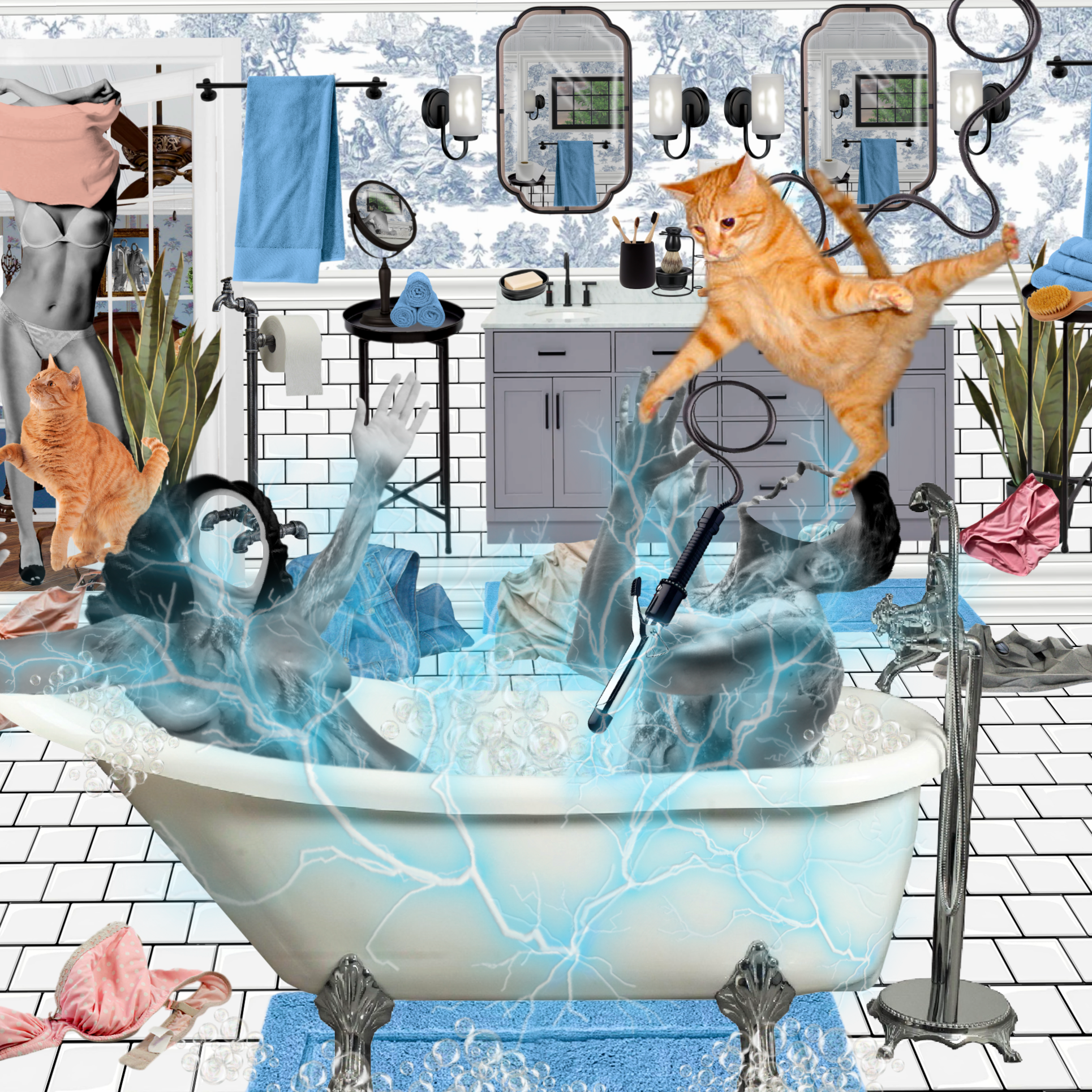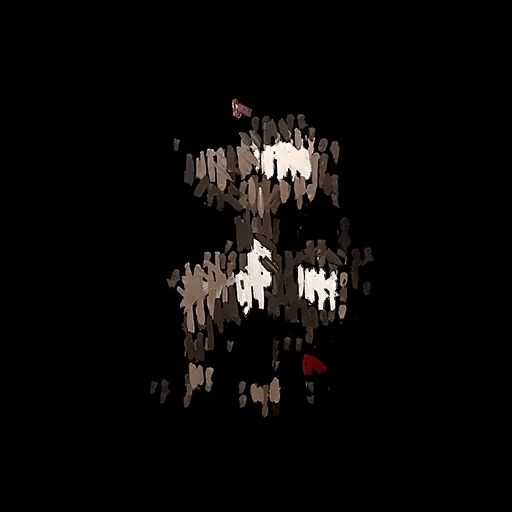About the Artist:
 Rebecca Rose, image courtesy of Artist
Rebecca Rose, image courtesy of Artist
Rebecca Rose is an award winning artist exploring various collage methods which include: sculptural, digital, immersive, and holographic. Rose's work is collected across several private collections and exhibited globally. Her work has been showcased amongst reputable institution's, galleries, and art fairs such as the Andy Warhol Museum, the 2017 Whitney Biennial held at the Whitney Museum, Art Miami, and Beijing Design Week. Rose has also been awarded prestigious fellowship opportunities from residency programs such as Ox-Bow/SAIC and the Joan Mitchell Foundation. Additionally, Rose has been a recipient of grants co-sponsored by the Robert Rauschenberg and The Willem De Kooning Foundations. Rose currently lives and works in Florida.
Rebecca's work has consistently evolved over the years from tangible collage work to 3D digital work. The approach to her practice as well as her interests are rooted deeply within how technology may offer additional layers to how a viewer may experience and interact with her work. It is through the intersection of art and technology that she hopes to create seamless narratives that challenge the viewer to step into and truly immerse themselves with the story before them.
Her incredible talent in visual storytelling allows viewers to interact and experience her work through these multi-dimensional realities. Asking us as the observer to question what we see before us as a reflection as well as introspection.
The Interview
1. Paloma: Could you provide insight into the inspiration behind the creation of this series and the themes that influenced both the concept and narrative?

Eskimo Pie, 2024
Rebecca: The Valentine's Day Massacre evokes mixed sentiments – for some, it's a day of love, while for others, it's approached with dread. This series introduces a touch of dark humor to the holiday, recognizing the inherent connection between love and death, which goes together like pb&j. Drawing inspiration from Shakespearean tragedies, these narratives present a blend of humor and implausible scenarios, offering a unique perspective on the complexities of love during this polarizing holiday we call Valentine's Day.
For example, St. Valentine’s execution is the origin story of Valentine’s Day and is pretty gruesome for a holiday that is dedicated to love. The celebration of Valentine's Day, as we know it today, pays homage to Saint Valentine and is intertwined with multiple origin stories. One of these narratives harks back to both Christian and Roman traditions, where Saint Valentine, a priest in the third century under Emperor Claudius II's rule, defied the emperor's decree against young men marrying. Despite the prohibition, Valentine continued to perform marriages in secret, an act of love that ultimately led to his execution after being beheaded on the day now dedicated to love.
Another tale links Saint Valentine to assisting Christians in escaping harsh Roman prisons, culminating in his untimely demise. Despite the variations in these stories, a common theme emerges – Saint Valentine faced a cruel fate for his compassionate and love-filled actions. Yet, what prevails through time is the essence of love, transcending the darker aspects of death and crime associated with the tales. Today, Valentine's Day stands as a commemoration of love and romance, embodying the enduring spirit of affection that has outshone the narratives of adversity.
It is then no wonder that these themes around love and death and their association to this series which holds in truth both realities of this day which we call Valentine’s Day. It is through these artworks we can explore these lesser known truths or perhaps less explored realities in the darker side or correlations of this day.
Furthermore, in reflecting on this series, I've had the opportunity to navigate through my personal encounters with violence and murder. The portrayal of themes like violence, jealousy, and crimes of passion resonated with my own experiences. Regrettably, I dealt firsthand with the tragic event where my best friend of 16 years was shot by her husband, who then turned the gun on himself. The haunting memories of the calls I made to the police department linger. This series, in its exploration of the harsh realities of life, might serve as a means for me to come to terms with the profound impact of such cruelty in the world. I won't delve into the specifics, but this narrative has become a channel for my journey of reconciliation.
Not many women create works of art centered around themes of violence, yet why is it that women are so drawn or fascinated by tv shows centered around the very theme of crime and violence? I can think of few artists whose work reflected or depicted this fascination of crime. These include the American sculptor Frances Glessner Lee, whose work helped shape modern forensics as well as the Italian Baroque painter Artemisia Gentileschi, who is best known for her painting titled Judith Slaying Holofernes, c. 1612-1613, which depicts the brutal assassination of Assyrian general by the heroine Judith.
"This begs the question of why we don't see as much art depicting violence from the female perspective. Is it too taboo for us to depict? This collection challenges that." - Rebecca
 Boom Bang Pow, 2024
Boom Bang Pow, 2024
2. Paloma: This is your first lazy mint on SuperRare, what would you say attracted you to this model for releasing this specific body of work? How does your artistic style evolve or adapt when working on a series compared to standalone pieces?
Rebecca: I like that the supporters of my work as well as my stakers will be given the unique opportunity to be granted early access to the release of this collection.
What intrigued me most about SuperRare's model was the element of mystery it introduced. The idea of only revealing artworks gradually, as prior pieces are collected, added an exciting layer of anticipation for both myself and potential buyers. It felt like a captivating way to engage collectors and build excitement around the release. As for how, I have approached this body of work I have done so similar to how I would prepare for a solo exhibition. I deliberated between crafting a series focused on a single couple or exploring standalone narratives with varied characters within the theme of tragic love. Ultimately, I opted for the latter, drawn to the opportunity to delve into diverse stories across multiple works. I wanted each piece to contribute to a collective theme while maintaining its own unique identity, much like the different types of Valentine's Day cards symbolize various expressions of love.
Ultimately, my decision to release this specific collection of work on SuperRare I think reflects a careful balance between my artistic vision for this series as well as the platform dynamics offered. It's about creating an experience that captivates and resonates with viewers and collectors, while also offering them a rich and multifaceted journey into the world of tragic love which encapsulates my series Valentine’s Day Massacre.
3. Paloma: You created 10 pieces for this collection. Let's dive into the specifics around one of the pieces you created.
 Que Hiernes Y Que Matas, 2024
Que Hiernes Y Que Matas, 2024
Rebecca: Similar to my Deepcuts, each piece within this series draws inspiration from songs. In the case of "Que hieres y que matas," the source is the theme of hatred and betrayal expressed between lovers in "Rata de Dos Patas." The narrative revolves around the protagonist, scorned by a conceited and adored bullfighter, a result of his own arrogance. She takes revenge by tampering with the bull's feed, adding coffee beans and chili peppers to antagonize the animal before the bullfight. As we move through the tunnel run, she lights a candle, praying for the success of her plan, while the bullfighter remains unaware, looking back at her. The arena comes alive with the bull kicking up dirt, and the matador revels in the admiration of women. The climax unfolds as he is fatally gored in the chest, and our main character, witnessing the spectacle, achieves her revenge.
I try not to include visual words, if I can help it. I learned from watching silent films that the absence of language appeals to a wider international audience because there’s no longer a language barrier. So instead, I use visual symbols like coffee beans and chili peppers instead of letters on the burlap bags in the bull stable.
4. Paloma: Can you elaborate on any symbolic motifs or recurring elements in this collection that hold personal significance for you?
Rebecca: Certainly, two central themes for me are love and death and a three-act play. Throughout the collection, I incorporate various filmmaking techniques, including storyboards, Dutch camera angles, and mise-en-scène, reminiscent of Rear Window. The animations' keyframes are structured like stage flats in a theater, with each piece comprising approximately 200 distinct collaged assets. It's important to note that these assets are not 3D; instead, they are collaged 2D elements arranged in three dimensions. Each asset is meticulously hand-cut and placed, contributing to the intricate and personal nature of the collection.
5. Paloma: Your artistic repertoire often features faceless characters and symbolic imagery. Could you delve into the intentional decisions behind incorporating or omitting faces and symbols in this specific collection, considering their role in shaping the overall narratives?
Rebecca: Faces are removed to represent all of us, yet none of us. It allows the viewer to place themselves in the situation of any figure and step in the shoes of different characters. When we look at an image with a face, sometimes the situation, feeling, or meaning behind the piece is wrapped up in the identity of whom it visually represents. By removing the identities the figures can be anyone. If a main character is present, they intentionally face forward towards the viewer for a stronger connection while side characters are in profile or quarter view.

Comedy Tonight, 2024
In this collection, particularly in the artwork titled "Comedy Tonight," we observe multiple bad dates unfolding simultaneously. Chaos ensues in the midst of it all, and notably, this is the only piece in the series where no one actually dies. Instead, it captures the moment right before violence erupts, serving as a prelude to the impending bloodshed. Despite the faceless characters, the deliberate use of silhouettes aims to convey the emotions within the room and the expressions of each individual on their separate dates. In contrast, at the center of the tumult stands the comedian, providing a juxtaposition to the chaos and emphasizing the absurdity of the unfolding events before him. This intentional composition adds layers of meaning, exploring the dynamics of the scene and the imminent shift from lighthearted chaos to a more ominous atmosphere.
6. Paloma: What do you want the biggest takeaway from this collection to be?
Rebecca: The primary message I aim to convey through this collection is to unveil the authentic origins of this holiday and its transformation into a day of love, despite its historical association with tragedy. I want to underscore the evolution of narratives over time, highlighting our collective tendency to reshape realities for a more positive outlook. As a society, we consistently alter the narratives, turning what was once rooted in tragedy into the celebratory occasion we know today – a day adorned with chocolate hearts and balloons.
Looking to secure one of these 10 artworks?
This series release will be gated for the first 24 hrs to all stakers in Rebecca's pool on @Rare_Protocol + RarePass holders. Stake any amount of $RARE in @rebeccarosenft’s Community Pool before the end of the day on February 13th to be allowlisted for the gated release on the 14th .
You can find Rebecca's staking pool below: https://app.rare.xyz/profile/0x38e23cea342deea0744a4f68780053f347b8bfa6/pool.




